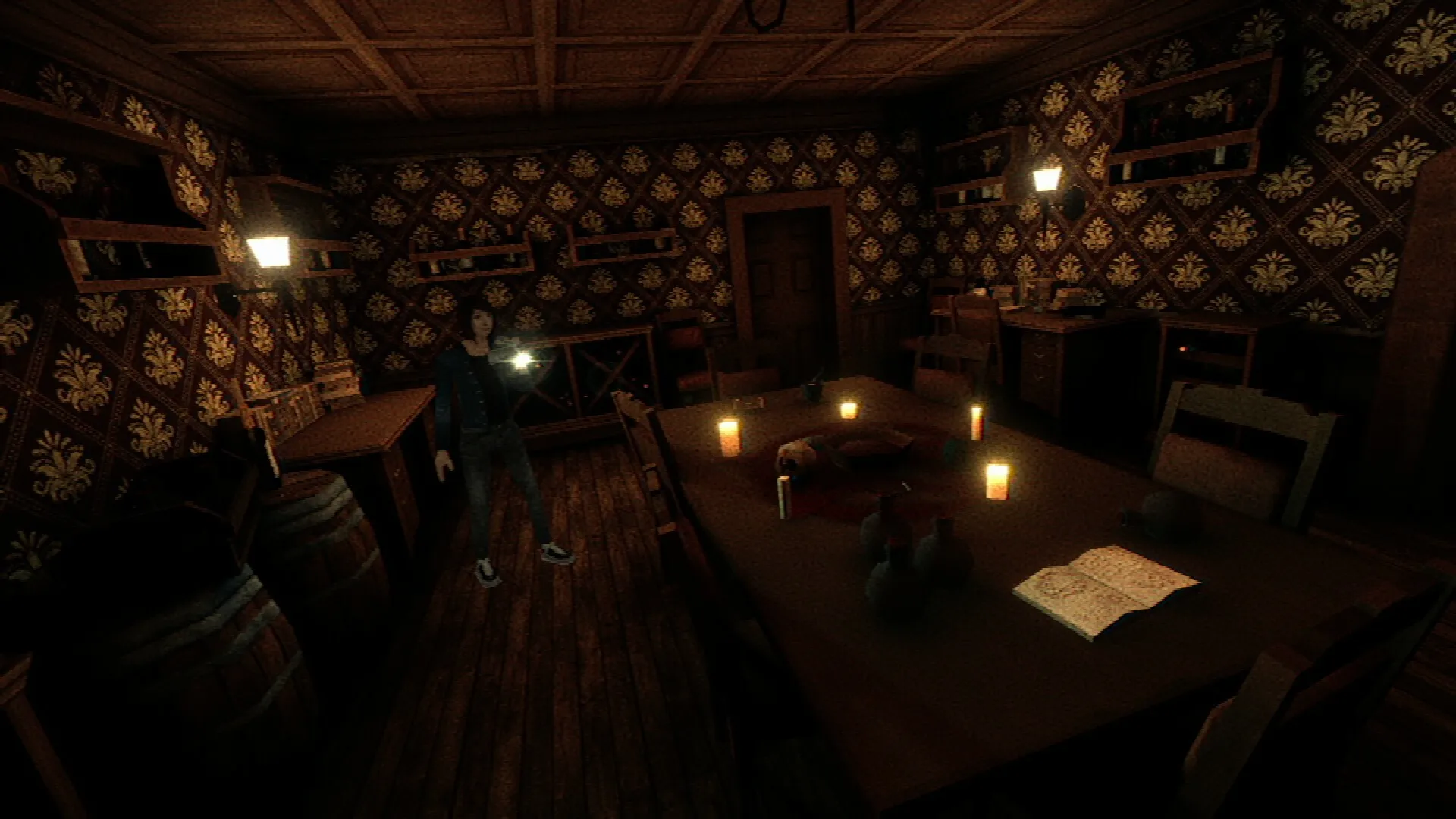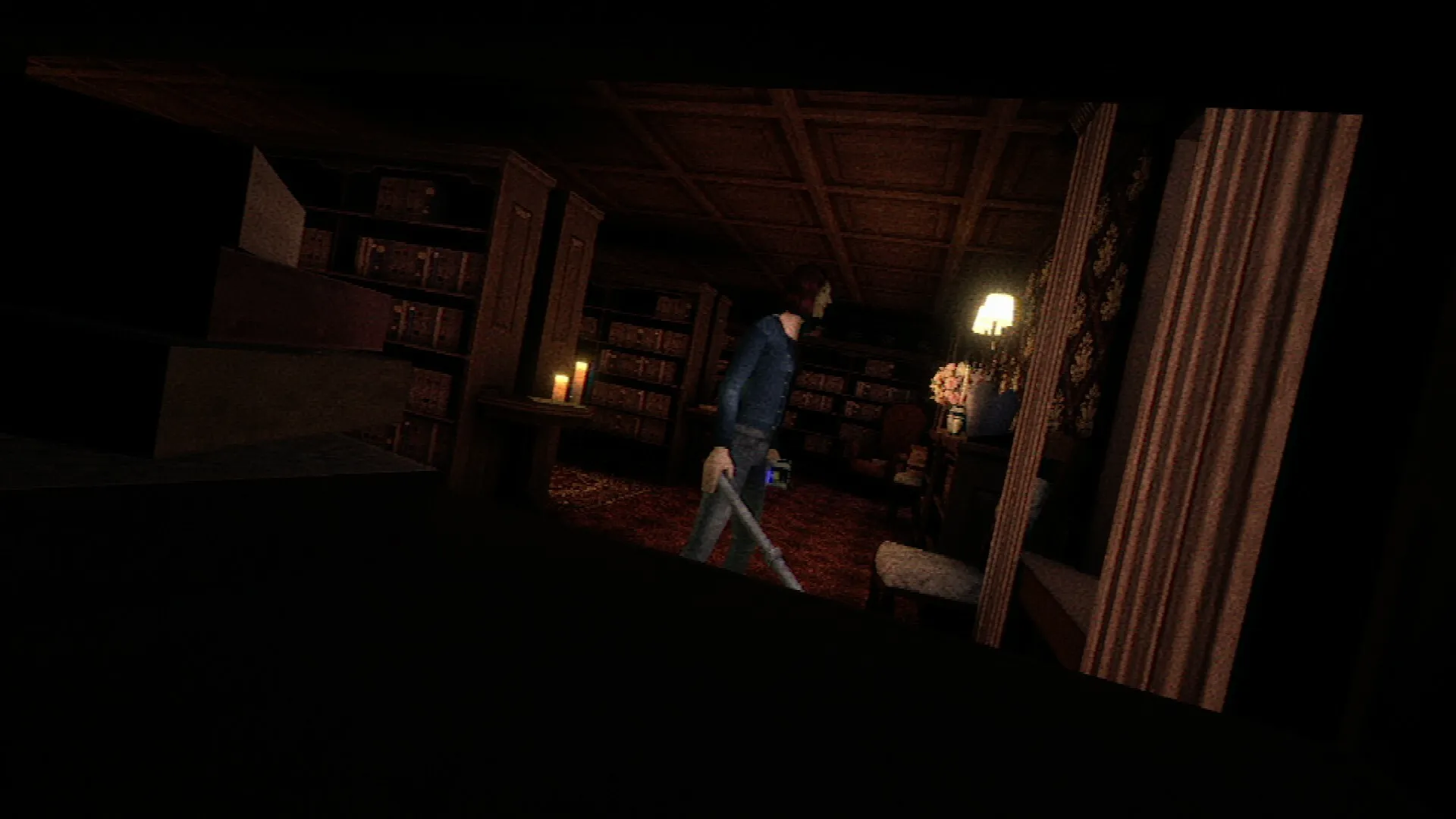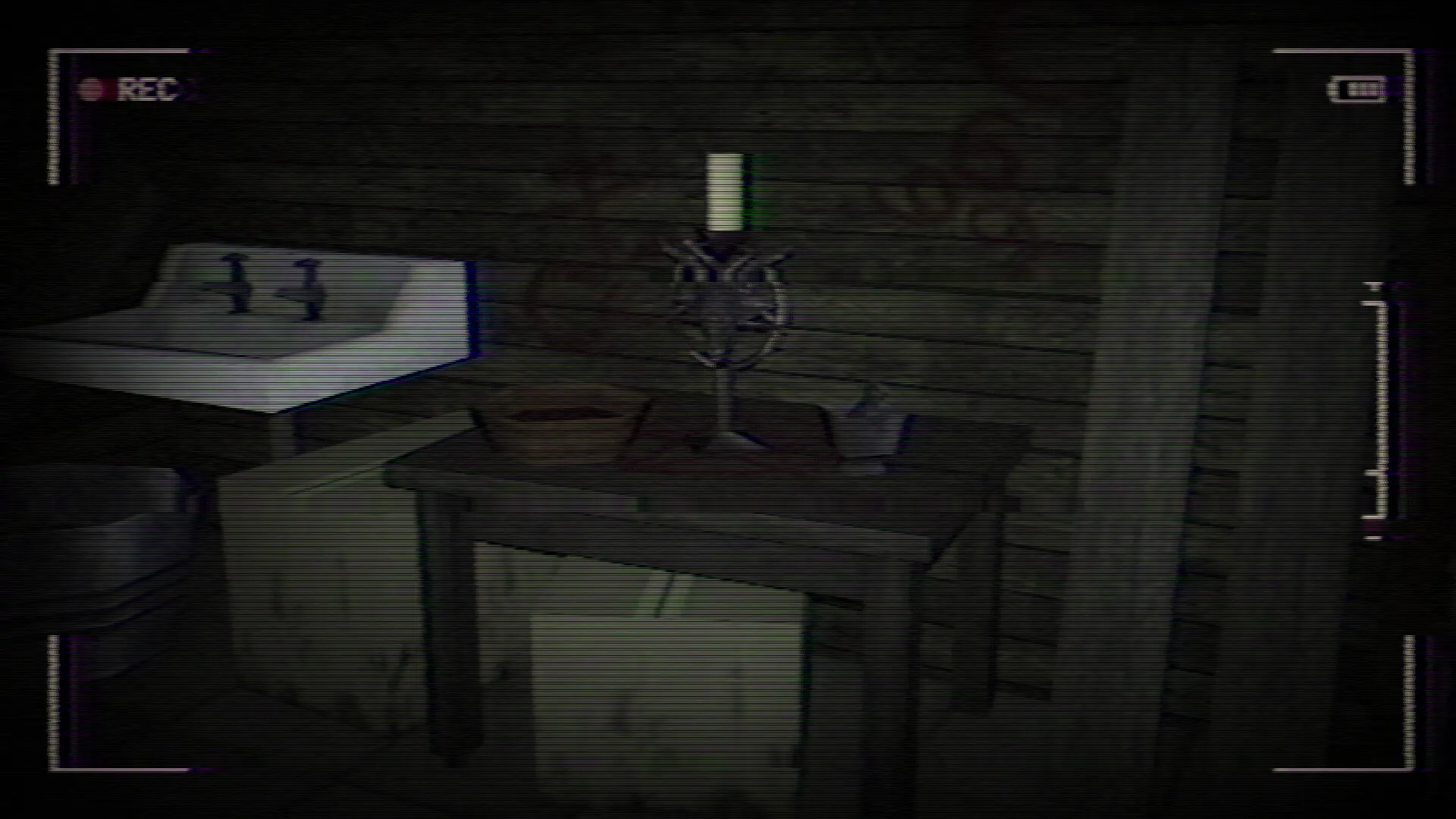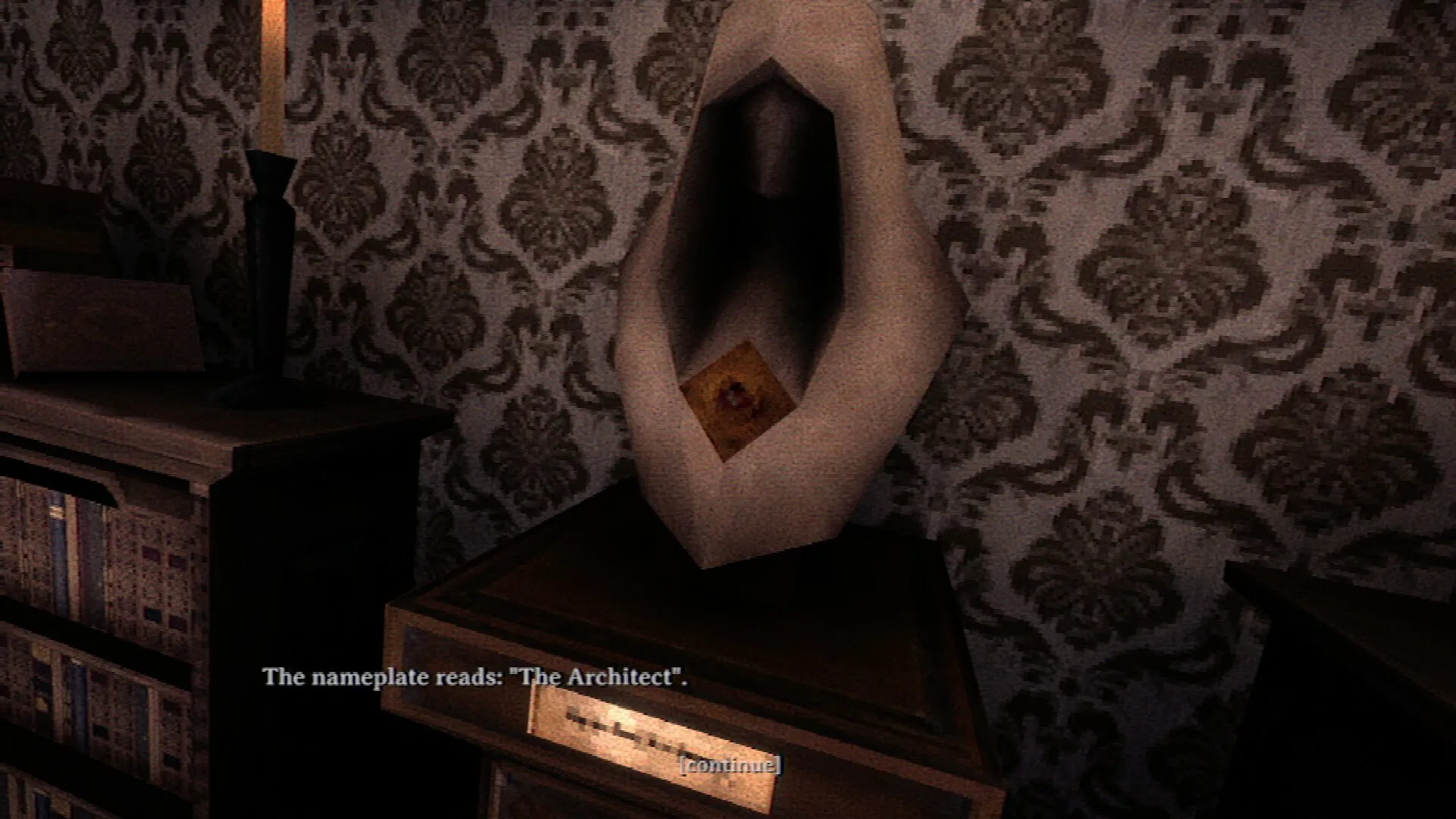The Fear Business emerges as a heart-pounding tribute to the golden age of survival horror, channeling the pixelated terror of PlayStation 1 classics while carving out its own distinct niche in the genre. Selewi created this indie horror experience, sending players back to a world of grainy graphics, fixed camera angles, and pulse-racing encounters that feel familiar and new.
Set in the tranquil village of Black Hill, the game follows Sarah McPherson, a struggling journalist looking for her big break. What began as an investigation into inexplicable disappearances swiftly devolved into a nightmare of cult conspiracies and unrelenting pursuit. Players are locked in Solomon Manor, a complex setting that serves as both a playground and a prison, reminiscent of Resident Evil’s renowned Spencer Mansion.
The game’s visual style is a deliberate tribute to the low-polygon aesthetics of late-1990s horror titles. Jagged edges, clunky graphics, and purposely low visual fidelity are not shortcomings but deliberate design decisions that create an uncomfortable nostalgic atmosphere. It’s like discovering an old VHS tape of a horror film: unpolished, imperfect, yet completely enthralling.
At its foundation, The Fear Business is a love letter to an age of horror games that changed how we experience fear through interactive media. The game does more than just copy; it celebrates the mechanics and atmosphere that helped make survival horror a groundbreaking genre.
Shadows of Suspicion: Unraveling Black Hill’s Mysteries
Sarah McPherson is not a typical journalist. She’s looking for a story that can rekindle her career as she teeters on the edge of being irrelevant professionally. When she hears tales of unusual disappearances in the small community of Black Hill, she sees an opportunity for forgiveness glimmering like a distant light.
The investigation begins in a dirty motel bar, where locals speak quietly about missing travelers and ominous tales. Each interaction reveals another layer of the town’s frightening mystery. To progress, Sarah must manage unusual social encounters, such as beating an arcade game to activate an interview or searching down a missing individual just to talk with another witness. These narrative riddles reflect the game’s overall structural approach, in which progress is achieved by cleverness and tenacity.
A strange hooded person emerges as her unexpected guide, proposing she go to Solomon Manor, the epicenter of local conspiracy beliefs concerning the Crimson Society, a potentially dangerous cult. Despite the apparent risks of accepting transport from a stranger, Sarah’s urgency outweighs her journalistic caution.
Solomon Manor serves as both her hunting ground and potential grave. The camcorder goes from a simple recording device to a survival tool, allowing her to document evidence while navigating dangerous environments. Its first-person perspective is a physical and metaphorical prism through which players can explore the manor’s dark secrets.
Investigative journalism tropes and traditional horror conventions are masterfully combined in the narrative. Sarah isn’t just chronicling a story; she’s stuck within it, with each unearthed document and solved puzzle bringing her closer to understanding the terrifying truth of Black Hill’s missing citizens.
Her ultimate goal moves from professional ambition to simple survival, as the boundary between reporter and potential martyr blurs with each heart-stopping moment.
Survival Tactics: Navigating Terror’s Intricate Playground
The Fear Business urges players to explore and requires strategic survival. The gameplay is a careful balance of resource management and nerve-racking encounters, with each decision determining the difference between progress and death.
Inventory management becomes an essential skill. Sarah can initially carry only four items, which can be increased to six with patient research. Each slot is valuable; should you preserve that wooden board for defense against Goat Face or trade it for a crucial puzzle key? The confined space pushes players to make frequent, high-stakes decisions that reflect traditional survival horror tropes.
Goat Face stands out as the game’s most unpredictable threat. Part slasher villain, part environmental hazard, he turns Solomon Manor into a living nightmare. Only momentarily stun and evade can players eliminate him. His appearances are characterized by abrupt static interference, creating a palpable sense of approaching danger. Wooden boards and metal pipes provide a little respite, but they shatter soon, turning each encounter into a heart-pounding game of cat and mouse.
Puzzle design takes a refreshingly basic approach. To progress, players will require good observation rather than advanced calculus. The challenges range from finding obscure symbols to playing specific piano note sequences. These puzzles aren’t about complexity but immersion; each completed obstacle feels like another layer of the manor’s terrible past has been peeled away.
The save mechanism adds its layer of stress with Devil Shrines. Each shrine may only be utilized once, and extinguishing its candle permanently removes the illumination from the room. This feature elevates saving from a routine chore to a strategic decision with potential implications, giving an extra psychological strain.
Exploration fosters curiosity. Solomon Manor progressively discloses its secrets, with hidden tunnels and locked rooms inviting players to delve further into its mysteries. The environment takes on its own personality, becoming claustrophobic, gloomy, and full of unsaid threats.
Tank controls and fixed camera angles are not design limitations but intentional decisions that enhance the game’s classic horror vibe. Every difficult movement and blind corner becomes part of the experience, channeling the greatest (and most terrifying) aspects of PlayStation-era survival horror.
Pixels of Panic: Visual Terror Reimagined
The Fear Business doesn’t just reproduce the PlayStation 1 period; it resurrects it with loving, gruesome detail. The visual design intentionally homages the horror games that defined a generation, transforming technical limitations into narrative strengths.
Low-poly models produce a purposefully unpleasant look. Jagged edges and pixelated textures are not defects but expertly created weapons of atmospheric horror. Solomon Manor looks like a nightmare from a late-90s horror game, with sharp edges and murky textures that throb with unsaid malice.
The camcorder serves as the game’s visual heartbeat. Its user experience is reminiscent of the original VHS interface design, with grainy overlays and flickering edges. When Goat Face approaches, the screen erupts in static, creating a more effective visual metaphor for terror than any high-definition representation.
Goat Face is a masterclass in monster design. His goat-headed silhouette is equal parts human and nightmarish, blending the familiar with the truly abnormal. Whether he’s a guy in a mask or something more supernatural is intentionally vague, allowing players’ imaginations to fill the terrifying gaps.
Lighting is key in transforming commonplace areas into potential death traps. Shadows lengthen unnaturally, interiors fall into near-total darkness, and the camcorder’s restricted lighting provides a constant sense of vulnerability. Each room feels like a potential trap, with an environmental design that puts players on edge.
The game’s visual approach focuses on psychological impact rather than photorealism. Every pixelated texture and clumsy character movement serves as an intentional invitation into a world where horror exists in the gaps between visible and hidden.
Sonic Shadows: Acoustic Terrors Unleashed
The Fear Business uses sound as a weapon of psychological warfare. The audio design enhances the game’s visual appeal and plays an important role in the terror narrative.
Static becomes a language of fear. When Goat Face approaches, the soundtrack changes from quiet ambient sounds to a cacophony of electronic interference. Each crackle and blast of white noise is an auditory warning system, transforming sound into a survival mechanism that keeps players on edge.
The vocal performances convey the raw desperation of survival horror. Sarah’s vocal style conveys how her journalistic determination gradually gives way to her primal survival instinct. Supporting characters, from the enigmatic locals to the mysterious hooded stranger, are delivered with a deliberate understatement that alludes to deeper, darker mysteries.
Ambient sounds transform Solomon Manor into a living organism. Creaking floorboards speak of unseen movements, and distant growls indicate that something is always lurking just outside your line of vision. The aural design generates negative space or intervals of near silence that are more terrifying than any direct interaction.
The musical score falls somewhere between classic horror soundtracks and experimental noise. The tracks alternate between subtle suspense and sudden, shocking sonic stings that reflect the unpredictability of Goat Face’s performances. Orchestral components combine with electronic distortions, creating a sonically exotic realm that feels familiar and utterly alien.
Each audio element works together to transform The Fear Business from a game into an immersive nightmare in which sound is viscerally experienced rather than just heard.
Navigating Nightmares: Controls Between Past and Present
The Fear Business treats control mechanics like a time capsule of survival horror nostalgia. Tank controls are more than just a throwback; they’re an intentional design decision that turns mobility into a psychological struggle. Each step feels weighty, each turn a calculated risk in Solomon Manor’s cramped spaces.
Fixed camera angles become more than just a visual approach; they’re a storytelling tool. Players navigate blind corners and restricted vistas, never knowing what awaits beyond the frame. It’s a masterful approach to create tension, with the limitation of vision becoming an integral part of the horror experience.
The camcorder stands out as the game’s most creative control tool. It’s more than just an inventory item; it’s a multi-use survival tool. Players transition to first-person perspective, illuminating gloomy locations, capturing critical evidence, and uncovering hidden elements that would otherwise be unseen. Switching to a camcorder view feels like removing a layer of reality to reveal the unseen horrors beneath.
UI design evokes the aesthetic of late-90s technology. Menus look like a classic camera interface, with pixelated visuals and simulated recording indicators. Inventory management becomes a puzzle in and of itself; with only four (expandable to six) item slots, each choice feels like a significant decision.
The number of interaction points is purposely kept to a minimum. Players cannot sprint or perform intricate maneuvers, heightening their sense of vulnerability. Each contact, whether picking up a key or completing a puzzle, necessitates deliberate, sometimes awkward navigation that reflects the protagonist’s struggle for survival.
These control options are not limitations but a meticulously crafted language of terror. The Fear Business recognizes that true horror exists at the moment between wanting to move and being able to move.
Echoes of Darkness: Revisiting Solomon Manor’s Secrets
The Fear Business is a short experience, yet it delivers more terror per minute than most horror games that last for hours. The game, which lasts around 3-5 hours, demonstrates that great horror is about intensity rather than duration.
Multiple difficulty levels greatly alter the experience. In standard mode, players face a carefully balanced task. When you hit the difficult setting, Solomon Manor transforms into a cruel gauntlet where every resource feels like a valuable lifeline. The toughest option removes the most forgiving elements, transforming each encounter into a true test of survival abilities.
Speedrunners will discover a playground of strategic shortcuts. The game’s fixed camera angles and methodical movement controls provide a unique challenge: optimizing routes becomes an art form. Hidden tunnels, precise puzzle solutions, and understanding Goat Face’s patrol routines are essential for reducing completion times by minutes.
Replay value derives from many narrative lines and hidden content. Thorough explorers can unearth further lore about the Crimson Society, decipher cryptic documents buried throughout Solomon Manor, and potentially disclose alternate storylines. Each game feels like revealing another layer of the town’s dark secrets.
Easter eggs are awarded to the most observant players. Subtle references to iconic horror franchises, hidden chamber layouts that alter between playthroughs, and rich contextual storytelling urge multiple investigations.
The game doesn’t just encourage repeat; it virtually challenges players to uncover every dark secret. Each visit to Solomon Manor promises something different, a testament to the rich design hidden behind the pixelated surface.
Technical Terrors: Performance Beneath the Pixel Veil
The Fear Business demonstrates that horror does not require cutting-edge technology. The game’s purposefully antiquated appearance leads to surprisingly strong technical performance across numerous platforms.
PC players will get a surprisingly varied experience. The game works smoothly on basic hardware, with low graphics options that maintain the characteristic PS1-era visual style. Steam Deck compatibility stands out as a feature with near-perfect portable performance that improves the game’s immersive aspects.
Technical stability stands out as an impressive accomplishment. Unlike many indie horror games, The Fear Business has very few bugs. The janky movement and visual flaws are deliberate design decisions, not technical shortcomings. Load times between areas are short, preserving the game’s tension without breaking immersion.
The game’s graphics options are purposely limited to reflect its nostalgic core. Players can change just the basics, like resolution and small visual filters. Still, the developers chose realistic experience over vast customization.
Input responsiveness is consistent with the game’s tank control design. What appears to feel like slight input lag is a well-designed feature that heightens the sense of vulnerability. Each slow turn and weighted movement contributes to the psychological horror experience.
The Fear Business boasts technical execution that punches well beyond its weight class for a low-budget independent release.
The Review
The Fear Business
The Fear Business is a wonderful love letter to survival horror's golden period, demonstrating that great terror isn't about photorealistic visuals or enormous budgets but rather about atmosphere, narrative tension, and understanding what makes players uncomfortable. The developers created an experience that feels both nostalgic and innovative by embracing the limitations of late-90s game design. Sarah McPherson's adventure through Solomon Manor is more than just a game; it's a masterfully built nightmare that pays homage to classic survival horror while carving out its distinct personality. The intentional visual and mechanical limits become storytelling aids, transforming potential flaws into strengths. At the same time, the game's short length may deter some players, its intense, meticulously crafted horror experience more than compensates. Each moment feels deliberate, and each puzzle and encounter is well planned to heighten psychological stress.
PROS
- Authentic PS1-era survival horror experience
- Innovative camcorder mechanics
- Compelling narrative with deep mystery elements
- Exceptional sound design
- Unique visual aesthetic
- Tight, focused gameplay
- Multiple difficulty levels
CONS
- Short gameplay duration (3-5 hours)
- Limited inventory management
- Potentially frustrating tank controls for modern gamers
- Niche visual style might not appeal to all players






















































